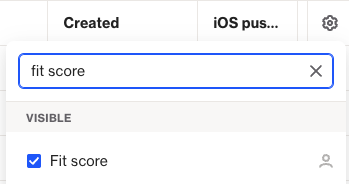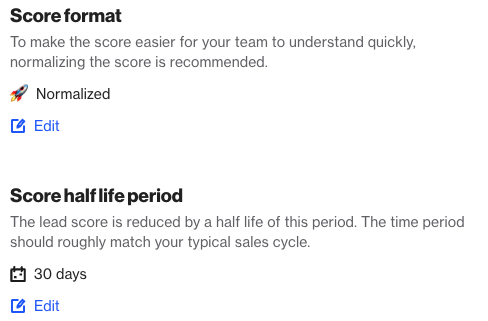Scores
Overview
Ortto’s Scoring feature allows users to create a customized scoring system to assess contacts' activity and attributes based on their most important metrics.
Accessing scores
To access the scores page, go to Settings > Customer data > Scores.
Managing scores
The scores page allows users to:
Scoring principles
When configuring a score, you can choose criteria and set a half-life period for score reduction. Like calculating engagement scores, the score decreases over time, with activities in the older half contributing half points and those in the recent half contributing full points (for activities only, filter criteria do not depreciate). Learn more about how the score is calculated.
Defining criteria
Each criteria added to the score can include a filter condition with multiple "Where" clauses or an activity. The filter condition or activity serves as the basis for the criteria. For instance, the filter condition or activity will become the criteria, for example, User session has occurred where page paths contain 'pricing'. Additionally, you will assign positive or negative points to each criteria to determine its value. For instance, you may assign -50 points to an unfavorable customer action such as Subscription cancelled has occurred.
Score limits
Score limits per plan:
- Professional: 1
- Business: 5
- Enterprise: 10
Maximum criteria per score by plan:
- Professional: Up to 8 rules (criteria) per score
- Business: Up to 10 rules (criteria) per score
- Enterprise: Up to 20 rules (criteria) per score
NOTE: The limits on legacy plans may differ. Contact support for help.
Create a score
- Navigate to the Scores page.
- Provide a name for the score, such as "Product score." This name will appear as the field name when viewing a contact’s score in your Customer Data Platform (CDP).
- Choose a Score format:
- Normalized — Creates a relative score compared to the 95th percentile. Normalized scores are represented by emojis.
- Whole number — Calculates an absolute score as points per activity multiplied by the number of activity occurrences.
4. Select your Score half-life period.
5. Add the Scoring criteria.
6. Toggle the score ON to initiate scoring for your contacts.
NOTE:
- You have the option to add or subtract points, with a maximum of 500 points added or removed per criteria.
- When setting up a filter or activity criteria, you can also include Where clauses. For instance > Deal won where value exceeds 50.
- Scores are calculated once every 24 hours at midnight in the account's timezone. Consequently, any activity occurring before the calculation may not be included in the score.
Once created, you can incorporate scores into your CDP view by clicking the cog icon, then searching for and selecting the scores.


Edit a score
- Navigate to the Scores page.
- Select the Score you'd like to modify.
- To Edit or Delete an exisiting criteria select the … next to the relevant criteria, once updated then select Save changes
- To Add a new criteria, select New criteria. Once created select Create criteria
Delete a score
- Navigate to the Scores page.
- Select the … next to the Score you'd like to delete.
- Select Permanently delete
- Type
PERMANENTLY DELETEto continue
NOTE: Once a score is deleted, it cannot be recovered.
Edit score format or half life period
- Navigate to the Scores page.
- Select the Score you'd like to modify.
- Select Edit to modify the format or half life period under their respective settings.

Utilizing scores in filters
You can utilize filters based on scores, such as identifying contacts with high lead scores, enabling your sales team to promptly engage with qualified leads. Additionally, scores can serve as entry criteria for playbooks and journeys.
Scores will also be visible in an audience's overview and in a contact's or accounts (previously organizations) view. However, scores that are turned off or have no calculation (i.e., no contacts meeting the criteria) will not be displayed in the audience's, contact's, or accounts (previously organizations) view.
NOTE: In both normalized and whole number scores within audience and accounts (previously organizations) views, the score value represents the average score of each person linked to the audience or accounts (previously organizations). Only scores with a value greater than 0 are considered in this average calculation.
Audience
In the audience tab, you'll find information on contacts meeting the normalized score criteria, including the count and percentage of contacts with specific score values (represented by 1 to 5 icons).
As whole number scores cannot be displayed in the audience tab, consider generating a report to visualize the score values effectively.
How are scores calculated?
Learn more about how Ortto calculates Scores.
